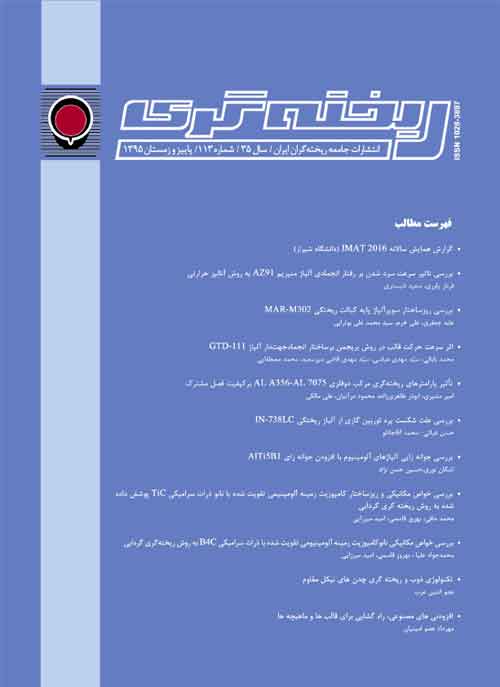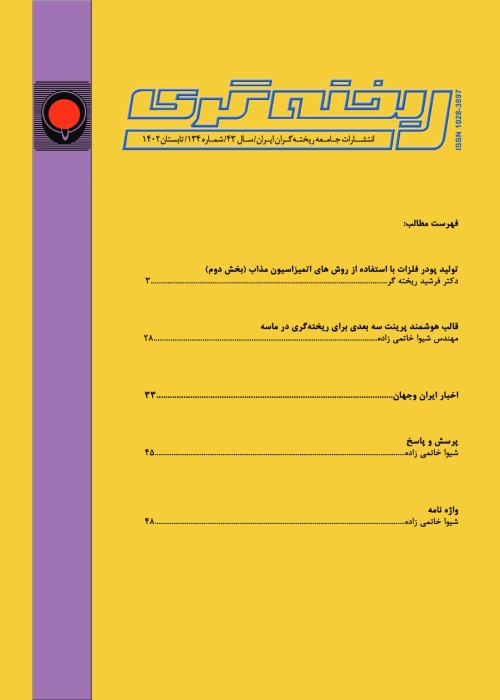فهرست مطالب

نشریه ریخته گری
پیاپی 113 (پاییز و زمستان 1395)
- تاریخ انتشار: 1395/12/20
- تعداد عناوین: 11
-
-
گزارش همایش سالانه IMAT 2016 (دانشگاه شیراز)صفحه 2
-
بررسی تاثیر سرعت سرد شدن بر رفتار انجمادی آلیاژ منیزیم AZ91 به روش آنالیز حرارتیصفحه 5
-
بررسی ریزساختار سوپرآلیاژ پایه کبالت ریختگی MAR-M302صفحه 13
-
اثر سرعت حرکت قالب در روش بریجمن برساختار انجماد جهت دار آلیاژ GTD-111صفحه 22
-
تاثیر پارامترهای ریخته گری مرکب دوفلزی AL A356-AL 7075 بر کیفیت فصل مشترکصفحه 29
-
بررسی علت شکست پره توربین گازی از آلیاژ ریختگی IN-738LCصفحه 34
-
بررسی جوانه زایی آلیاژهای آلومینیوم با افزودن جوانه زای AlTi5B1صفحه 40
-
بررسی خواص مکانیکی و ریزساختار کامپوزیت زمینه آلومینیمی تقویت شده با نانو ذرات سرامیکی TiC پوشش داده شده به روش ریخته گری گردابیصفحه 45
-
بررسی خواص مکانیکی نانوکامپوزیت زمینه آلومینیومی تقویت شده با ذرات سرامیکی B4C به روش ریخته گری گردابیصفحه 50
-
تکنولوژی ذوب و ریخته گری چدن های نیکل مقاومصفحه 55
-
افزودنی های مصنوعی، راه گشایی برای قالب ها و ماهیچه هاصفحه 62
-
2016 Imat Conference ReportPage 2
-
Effect of cooling rate on solidification characteristics of AZ91 magnesium alloy using cooling curve thermal analysisPage 5The application of cast magnesium alloys as the lightest structural metal is increasing due to the requirement for weight reduction in the automotive and aerospace industries. Most commercial magnesium alloys are based on the Mg-Al system (AZ and AM alloys) and casting is the most commonly used production process for magnesium components. Mechanical properties of cast alloys are strongly depend on their as-cast microstructure and it is related to solidification and cooling condition. In this research solidification characteristics of the most widely used Mg alloys, AZ91 alloy, has been investigated using cooling curve thermal analysis technique. For this purpose, cooling curves of AZ91 alloy have been plotted in six different cooling rates. The results show that by increasing cooling rate, the nucleation temperature of primary dendrites is increased and the nucleation temperature of eutectic phases is decreased. Microstructure and phases have also been investigated.Keywords: thermal analysis, solidification, AZ91 magnesium alloy, cooling rate, microstructure
-
Microstructure Investigation of Cobalt-Based Superalloy MAR-M302Page 13In this study, microstructure of as-cast cobalt based superalloy MAR-M302 is investigated by using optical microscopy, scanning electron microscopy equipped with energy dispersive spectroscopy. X-ray diffraction pattern is used for identify existent phases in as-cast super alloy. Metallographic investigations showed that as-cast MAR-M302 includes the MC carbides as a discrete, blocky dispersion with Chinese script morphology and the eutectics M23C6 and M6C carbides. The M23C6 and M6C carbides are lamellar eutectic with matrix as Great Island.Keywords: Microstructure, Heat treatment, MAR-M302, M23C6 carbide
-
The Effects of Withdrawal Rate in Bridgman Directional Solidification Technique on Structure of GTD-111Page 22In this study the effect of Bridgman technique withdrawal rate on structure of Ni-base superalloy GTD-111 has been investigated. So the withdrawal rate 2.5, 5 and 10 mm/min selected and effect of this variation on structure contain density of grains, deviation orientation, primary and secondary dendrite arm spacing were evaluated. It was observed increasing withdrawal rate cause density of grains increased but the deviation orientation, primary and secondary dendrite arm spacing decreased. It was also observed that by increasing the withdrawal rate, at first the number of freckle decrease and then increase. Thus, this result was obtained with investigation of alloy structure that by the increasing the withdrawal rate of a limit, risk of formation the freckle increase in alloy structure and this has a negative effect on the directional structure. This issue was observed in 10 mm/min withdrawal rate.Keywords: Ni-base Superalloy, Directional Solidification, Bridgman Technique, Withdrawal Rate, Macrostructure, Microstructure
-
Effect of Compound Casting Parameters of an Aluminum-Aluminum Alloy on the Interface QualityPage 29Aluminum is one of the most common metals used in industry and aluminum composites are highly regarded by engineers because of having simultaneously the desired physical and mechanical properties. Therefore, in this study, casting of aluminum-aluminum bimetallic composite samples of A356 and 7075 which are widely used metals in the industry have been done without surface preparation. With a constant volume ratio of metals, A356 melt was casted around the 7075 insert. In this paper, the melt temperature as one of the most important parameters affecting the quality of interface as well as the insert temperature and cooling the samples was investigated. Comparing the results of the optical microscopy indicate improvement of the interface quality with increasing the melt and insert temperature, due to the destruction of oxide layer caused by thermal stress between the metals. The results show that the cooling condition of the samples, has no significant effect on the quality of the interface.Keywords: Aluminum, Composite, Bimetal, Casting, Interface
-
Failure Analysis of IN-738LC Cast Alloy Gas Turbine BladePage 34
Turbine blades experience hot temperature and high level of stress in accordance with their place and the working condition. These blades which are produced from high strength superalloys with good resistance to the high temperature are mostly made by casting and forging processes. One of these alloys is the cast nickel base superalloy, Inconel-738. This alloy was used in the third row of the gas turbine, and was fractured in a short time. To figure out the reason of fracture, chemical analysis and mechanical tests was performed on the new and old blades that had been fractured after a great amount of time of work in an elevated temperature. The results from the tests for the new blade and the old one were compared with each other. Moreover, the microstructure and surface fracture of these blade were investigated in the root and blade locations. Consequently, the brittleness of blades which caused fracture is resulted from the formation of needle like carbides in the grain boundaries.
Keywords: Blade, Turbine Gas, Cast Alloy, Carbide, Fracture -
Evaluation of Al Alloys Grain Refinement with addition of AlTi5B1 inoculantPage 40In this investigation, influence of Ti and B in commercial pure aluminum and an Al-Fe alloy on the Grain refinement was studied by various addition of AlTi5B1.Grain refinement tests were performed at a cooling rate 15 C/s. The results showed that in aluminum and Al-Fe alloy the grain size decreases with increasing addition of grain refiner. It was concluded that for the same B content, the grain size was smaller in Al-Fe alloy. The difference in the grain sizes for the same content of B was almost 15μm. This is noticeable smaller than the difference between the grain sizes in samples with the same difference of growth-restricting factor made at slower cooling rates.Keywords: Grain Refiner, Cooling Rate, Grain Size, Growth-Restricting Factor
-
Evaluation of mechanical properties of Nano-composite aluminum reinforced by TiC by stir castingPage 45In the last few decades, the production of Aluminum Matrix Composite (AMC) has been attractive due to the enhancing the mechanical property of Aluminum. One the most important parameters in the production of metal matrix composites is the uniform distribution of reinforcing phase in the matrix. The stir casting method can produce composite by strengthening the Nano-particle in the uniform distribution of reinforcing particles in the matrix and high wettability, which is the most important parameter in determining the properties of materials on the Nano-scale. In this study, the aim is producing aluminum composites reinforced with TiC nanoparticles coated with aluminum to increase the wettability. After preparation of particles, they were added to molten aluminum alloy LM2 and after stirring over a period of time as a variable parameter, casting was done in the sand mould. To evaluate the mechanical properties of the composite the Brinell test was used for the determination of the hardness and the pin on disk test was used to measure the wear rate and the friction coefficient. The results show that the hardness of composite increases and. With the increase of stirring time, the weight loss decreased with respect to the base alloy and the coefficient of friction increases.Keywords: Mechanical properties, nanoparticle, Aluminum Matrix Composite, Stir casting, TiC
-
Evaluation of mechanical properties of Nano-composite aluminum reinforced by B4C using stir casting methodPage 50In the last few decades, the production of Aluminum Matrix Composite (AMC) has been attractive due to the enhancing the mechanical property of Aluminum. One of the most important parameters in the production of metal matrix composites is the uniform distribution of reinforcing phase in the matrix. The stir casting method can produce composite by strengthening the Nano-particle in the uniform distribution of reinforcing particles in the matrix and high wettability, which is the most important parameter in determining the properties of materials on the Nano-scale. The aim of this study is producing of aluminum composites reinforced with B4C nanoparticles coated with aluminum to increase the wettability. After preparation of the particles, they were added to molten aluminum alloy LM2 and after stirring over a period of time as a variable parameter, casting was done in the sand mould. To evaluate the mechanical properties of the composite the Brinell test was used for the determination of the hardness and the pin on disk test was used to measure the wear rate and the friction coefficient. The results of the present research show that the hardness of composite increases adding the strengthening Nano-particles and the weight loss with respect to the base alloy decreased when the stirring time increases. Also, the coefficient of friction increases.Keywords: Mechanical properties, nanoparticle, Aluminum Matrix Composite, Stir casting, B4C
-
Technology of Melting and Casting of Ni-Resist Cast IronsPage 55This study introduce Ni-Resist cast irons and the technology of melting and casting of these alloys. In comparison with regular grey and ductile irons, Ni-Resist cast iron have some differences in production technology which can effect on mechanical properties, microstructure and casting quality. For example, effect of chemical composition, residual magnesium, fading time, magnesium treatment, inoculation gating and risering design, and adding alloying elements and pouring the molten metal are different with regular cast irons.
-
Synthetic Solution for Molds and CoresPage 62


